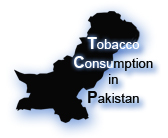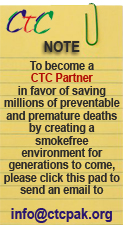


|
Pakistan with a population of 160 million is the 7th most populous country in the world. The health and demographic situation in Pakistan is characterized by a high birth rate (29 per 1000) a comparatively low death rate (8 per 1000) and a consequent rapid population growth rate of 1.9 %. The infant mortality rate of 72 per 1000 live births and maternal mortality of 400 per 10000 deliveries is still very high[i]. Tobacco use in Pakistan : Tobacco use in Pakistan is common and one of the highest in the South East Asian Region. There are about 22 million smokers in the country and 55% of the households have at least one individual who smokes tobacco[ii]. As a result Pakistan accounts for a sizeable proportion of the cigarettes consumed in South Asia as shown below in Figure 1[iii]. In Pakistan about 100,000 people die annually from diseases caused by use of tobacco.[iv]
|
|
|
Figure 1: Percentage of Total Cigarette Consumption in SA Region, 1999
Tobacco consumption does not only occur in the form of cigarettes but also includes beedis (hand rolled cigarettes), Huqqa (water pipe) and chewing tobacco. According to the National Health Survey of Pakistan 1998, 54% men and 20% women used tobacco in one form or the other.[v] WHO-EMRO (Eastern Mediterranean Regional Office) website[vi] quoting the National Health Survey[vii] states that 36 % of adult men and 9 percent of adult women smoke in Pakistan. Global Youth Tobacco Survey (GYTS) supported by WHO and conducted in Pakistan focused on adolescents aged 13-15 years. GYTS reported 1.7% of the students (2.5% boys and 0.5% girls) having smoked cigarettes in the month prior to the survey.[viii] The above information has been contributed by Dr. Ehsan Latif taken from his paper entitled: ‘An assessment of the impact of the Framework Convention on Tobacco Control on tobacco control policies in Pakistan’, submitted to London School of Hygiene and Tropical Medicine as partial fulfillment of MSc. Public Health course. |
|
|
[i] World Health Statistics 2007 http://www.who.int/whosis/en/index.html accessed 21 July 2007 (1600 GMT) [ii] Pakistan Health Education Survey, 1991. Ministry of Health, Government of Pakistan, Islamabad. [iii] Economics of Tobacco for the South Asia (SA) Region June 18, 2001 Available at http://siteresources.worldbank.org/INTETC/Resources/3759901089913200558/SouthAsia.pdf [iv] Pakistan Health Education Survey, 1999 –Pakistan Medical Research Council, G 5, Islamabad [v] Pakistan Medical Research Council. National Health Survey of Pakistan 1990-94. Islamabad, Pakistan: Pakistan Medical Research Council, Network Publication Service, 1998. [vi] Tobacco Control Country Profiles 2003, American Cancer Society, Atlanta, GA, 2003 http://www.emro.who.int accessed 10 July 2007 (1000 hrs GMT) [vii] Pakistan Medical Research Council. Pakistan Health Education Survey (ISBN: 969-499-003-3 [pbk]). Islamabad, Pakistan: Pakistan Medical Research Council, 2003 [viii] World Health Organization. Global Youth Tobacco Survey: Tobacco-free Initiative. Cairo, Egypt: World Health Organization Eastern Mediterranean Regional Office, 2001. |
 |
